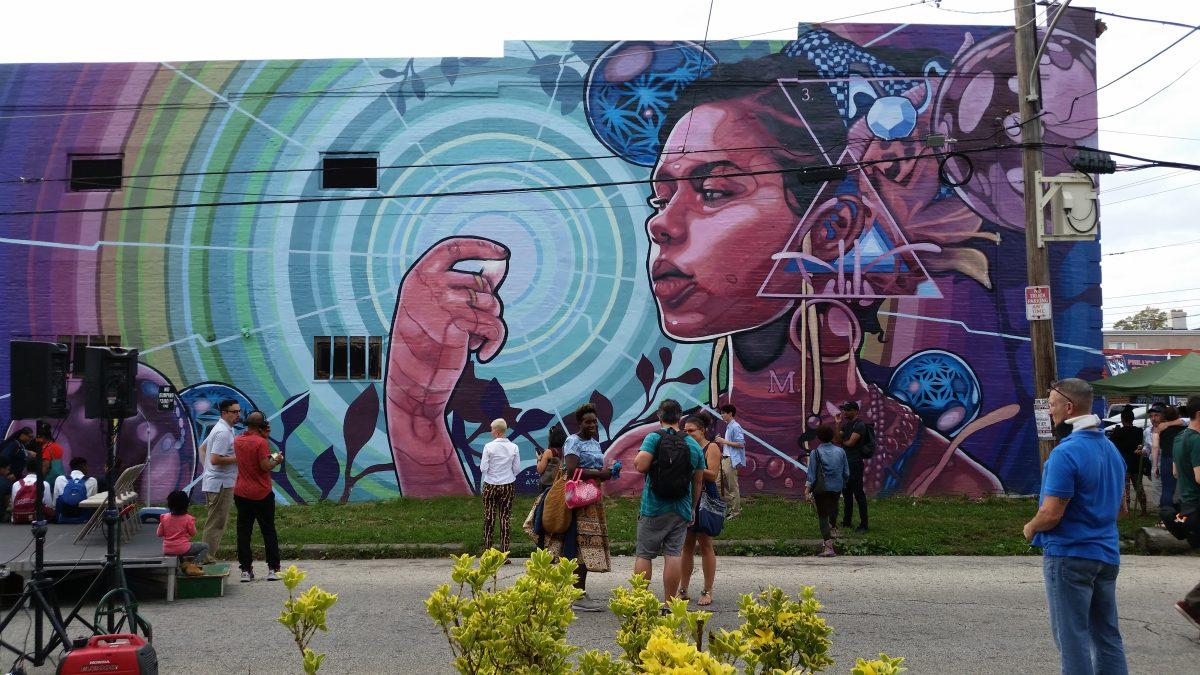Philly celebrates Mural Arts Month
Mural Arts Philadelphia, a public arts non-profit, launched its annual Mural Arts Month celebration with the dedication of a new augmented reality (AR) mural entitled “Dreams, Diaspora, and Destiny.”
The mural was dedicated on Oct. 9 on the 5300 block of Lansdowne Avenue in the Conestoga neighborhood of West Philadelphia.
The mural, is two stories high, the length of a city block and painted on the side of a warehouse building.
The project was a collaboration involving artist Joshua Mays, DJ and producer King Britt and student artists from The Haverford School and Mastery Charter at Shoemaker. The Philadelphia-based visual effects company, Blue Design, oversaw its AR integration.
Joshua Mays, lead artist and visual designer of the project, said this project has been his biggest collaborative work. The dedication for Mural Arts Month brought one of the largest crowds to his work that he has ever gotten.
“It creates a bit more of a direct bridge to the people in the neighborhood,” Mays said. “In terms of having people come together and really meditate on the value of what is produced, it adds to the value of the experience.”
Jane Golden, founder and executive director of Mural Arts Philadelphia, said that establishing a time for artists, patrons, communities and donors to show appreciation for each other gives the mural arts community something to look forward to.
“During the course of every year, we always do lots of dedications, but by curating it, adding in panel discussions, lectures, dedications, making sure it’s a really interesting mix of events, it’s like putting an exclamation point at the end of a sentence,” Golden said, “It’s fun, and it’s inspiring.”
Mural Arts Philadelphia, founded in 1984, has supported the creation of approximately 4,000 murals in Philadelphia and manages between 60 and 100 public art projects each year.
Mural Arts Month is celebrated in October of every year since 2000 to draw attention to art projects and to be a reflection of the program and its goals of supporting artists, local communities and civic voices in Philadelphia.
Britt was responsible for the audio elements of the mural. By using an app on a smartphone, viewers can experience a variety of sounds and on-screen visual effects that change as they move across different parts of the mural.
Britt said that the mural is a significant leap forward in technology and a way of attracting the general public to art and its potential to affect change, particularly among a younger demographic who might be intimidated by museums.
“It’s so important, because a mural like this and the technology overlaid with it is the next level for mural arts, but also it opens doors for people who are just walking by,” Britt said. “Art inspires. Even if you only get one person, it can change everything.”
Lynette Mukhongo, Ph.D., visiting professor of communication studies at St. Joe’s, said the murals in Philadelphia tell stories in unique ways.
“A lot of these murals are told by the communities, and the communities actually work on creating them,” Mukhongo said. “So it stops being something on the wall, but rather something the community owns, their own story.”
Golden said the representation of local artists and neighborhoods in public art is not only part of what distinguishes murals from other forms of art, but it is also a part of what sets Philadelphia’s murals apart from those in other cities.
“The murals in the city look like people who live here, and that’s a really big deal,” Golden said. “Sometimes I lose perspective, but recently these city council people [returned] from Atlanta and they said a bunch of out-of-town artists come in, do murals in and around the black community and leave. And then they came to Philly and they said, ‘Jane, we wanted to weep tears of joy that we saw ourselves on the walls.’”














































